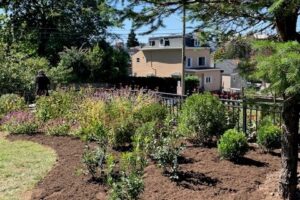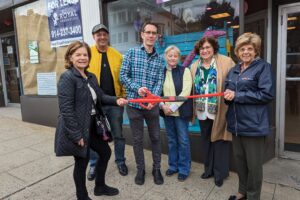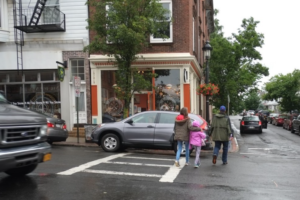One of the many positive things to come out of Sleepy Hollow’s public hearings on Lighthouse Landing, was the opportunity to speak with Nick Robinson. He joined the Planning Board when Don Stever stepped down to become a Trustee and has been its Chairman for the past four years.
Mr. Robinson’s specialty is environmental law and land development. He teaches Environmental Law at Pace University’s School of Law and actually helped develop the field of Environmental Law. "I went to Columbia Law School and graduated in 1970. Environmental Law didn’t exist then so I began applying law to questions of the environment and nature conservation," he said. In 1977 Pace University needed someone to develop its Environmental Law program and they chose Nick Robinson.
Lighthouse Landing encompasses a whole range of issues in Robinson’s area of law. "You have the Hudson River, Kingsland Point Park with park conservation questions, historic preservation issues regarding the Lighthouse, the old Dutch settlements, and the Pocantico River. You also have the questions of brownfield development and hazardous waste remediation. There are also the questions of mass transit, zoning and land use planning. All of this is basically what I teach," he said. When asked to "step up to the plate" and put his expertise to work, he was happy to do it. He and the six other members of Sleepy Hollow’s Planning Board have Mayor Zegarelli’s ear and, by his own account, the Mayor is fortunate to have a man of Robinson’s ability and dedication.
When asked what his overall impressions of the Lighthouse Landing were, as presented by the Roseland Property Company, he said, "I look at it from two points of view, the first being as the Chairman of the Planning Board. From that point of view I try to reflect the best planning principles under State and Village law, which may differ from my own personal point of view. We have a development which is a very good first draft of a concept for developing the site. Roseland has done a lot of constructive work in figuring out how to keep the river viewshed on Beekman Avenue and Beekman Place (the road that will lead to the Lighthouse). What we would like to see is, rather than have a lot of little narrow streets and blocks, that they broaden all the roads down there to make it more pedestrian-friendly. We would like more trees on the site, less dense housing and for them to open up the view sheds within the project as well as out towards the river. We would also like them to show a buffer between Kingsland Point Park and the development, which they haven’t done." Regarding the restoration of the Pocantico River, he noted that the Planning Board was quite sympathetic to the idea of opening up the Pocantico, and believes that it should be studied as "quite a plausible proposal."
With the Mayor defining Lighthouse Landing by three words — traffic, traffic, traffic — the question of mass transit has been raised, and whether or not a railroad station will be added to the site. The Planning Board has asked for alternatives in the event that Metro North does not approve the station, and those alternatives can include a smaller trolley or a "people mover" of some sort. In addition, the Board wants to see every existing or new road, that comes into or out of the site, examined. "Right now there is only Beekman Avenue, the viaduct, River Street, Hudson and Continental. You can’t put a road through Kingsland Park because it violates the Transportation Act. Originally the Park was strictly pedestrian and we would like to see that return," Robinson said.
Turning his attention to the east side of the railroad tracks adjacent to the Philipse Manor Restoration, Robinson noted that there needs to be a better delineation of where the underground historic sites are. State laws require that the Village look at archeology. "We don’t have to do the dig but we have to identify where the likely sites are. We know this was used by ships over a long period of time and most of the original harbor is under the parking lot," he said. Accordingly, once likely sites are identified, the standard practice is not to build at that location and further compact them.
As for density at the site the Board did not approach the issue in an abstract manner. "What we said was that if you (Roseland) took all our planning criteria into consideration, every time you adopted one of our recommendations you’d be eliminating a number of units. For example, Roseland has a large apartment block opposite the townhouses of Ichabod’s Landing. We told them to make a row of smaller townhouses rather than a large block of apartments. That change from a large bulky building to a smaller set of buildings will eliminate quite a number of units and automobiles. We told them to take the parking off of the road which leads to the park by the River. You don’t want to look over parked cars to look at the River; you don’t want to look from the River back at a parking lot. That’s going to mean that you have less vehicular trips in and out of the site, because parking would have to be put someplace else or wouldn’t be there at all. So, with widening the streets, cutting down on large buildings and restricting parking, you will cut down on the number of units substantially, and the number of trips into and out of the site," Robinson said.
Shifting to the possibilities of restoring the Pocantico River for flood control reasons, Robinson said of the GM site, "You have a real chance to reconfigure a part of that area and provide for some open space and a different kind of water view from the land. We’re really talking about reconfiguring a very large area." That possible reconfiguration is another means of not having Lighthouse Landing looking like a "stock development pattern" having no identity with the River or the Village. "We want something that is uniquely a Hudson feeling," he added.
Although the main shopping area of Lighthouse Landing has architecture that compliments the Village, Roseland has made no attempt to have the look of the residential area follow suit. "We don’t want this to look like we’re importing blocks of apartment buildings from the Bronx or down in the City. If you take a look at the center area of the plan they’re just big blocks of buildings," Robinson said. The Planning Board has asked Roseland to provide actual computer simulations, and not nice artist renditions, of what the residential and the entire site will look like. With the Kendal-on-Hudson retirement center, the Board asked for computer- simulated viewshed analysis in every possible direction from which the site could be seen. They want the same for Lighthouse Landing. "Then the Board of Trustees and the public will have real views to look at," he added.






